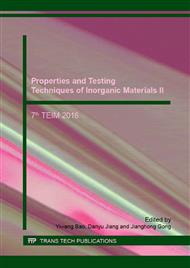p.481
p.490
p.495
p.500
p.505
p.510
p.515
p.521
p.527
Water Absorption and Hydration Products of Metakaolin Modified Mortar
Abstract:
The compressive strength, water absorption and hydration products of mortar with metakaolin addition were characterized by a range of techniques to evaluate the effect of metakaolin on the properties and hydration of mortar. Metakaolin is more effective on the improvement of compressive strength of mortar after curing for 7 days, due to the refinement of pore structure and pozzolanic reaction between metakaolin and calcium hydroxide. Water absorption of mortar was reduced by introducing metakaolin, especially in the very early age, due to the optimization of packing density of mortar by superfine metakaolin particles. There is no correlation between compressive strength and water absorption of mortar due to the differences between mechanisms affecting the compressive strength and water absorption of mortar by metakaolin. The hydration products of mortar without metakaolin were Portlandite and ettringite. Additional hemicarboaluminate and monocarboaluminate were identified in mortar with metakaolin addition. Metakaolin addition reduced the calcium hydroxide content due to the pozzolanic reaction.
Info:
Periodical:
Pages:
505-509
Citation:
Online since:
January 2017
Authors:
Price:
Сopyright:
© 2017 Trans Tech Publications Ltd. All Rights Reserved
Share:
Citation:


